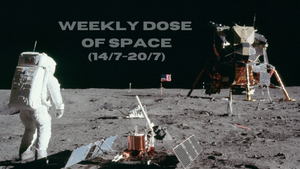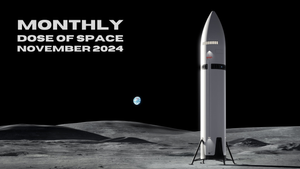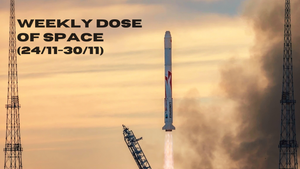
Weekly Dose of Space (14/7-20/7)
Welcome back to Weekly Dose of Space! Last week saw only one orbital launch worldwide. This week, Artemis II hardware was also on the move, Astra was returned to private ownership, and a leadership change occurred at Firefly. As always, we'll also look ahead to what the worldwide launch schedule might look like next week.
SpaceX
This week at Starbase began on the 15th when Booster 12 began propellant loading. Not too long after propellant loading began the oxygen tank was almost completely filled and the methane tank was partially filled. This was for a static fire as Booster 12 lit all thirty-three of its engines for a full-duration test, according to SpaceX.
DAMN 🤩 https://t.co/2gZ6XbUipy pic.twitter.com/8Esj4OslVw
— Cosmic Nxws (@cosmicnxws) July 15, 2024
One of the views released by SpaceX of Booster 12 performing its static fire via CosmicNxws on X.
The following morning, the second module of the second launch tower at Starbase was lifted and attached. Not long after that Booster 12 was lifted off of the orbital launch mount and placed on a transport stand, a little later on it was moved from the launch site to the production site.
In the early hours of the 17th, the third module for the second launch tower was rolled out from to the launch site. This module was attached to the crane overnight and lifted onto the tower on the 18th. The following day, July 19th, an unknown test tank left the production site and headed to the Massey's test site, SpaceX doesn't say what these test articles will be tested for. July 19th also had some of the scaffolding around Ship 30 come down, as work on replacing its thousands of thermal protection tiles is believed to be almost done.
Launches This Week
July 19th - Long March 4B with Gaofen 11-05
This week's only launch was a Long March 4B lifting off from Launch Complex 9 at the Taiyuan Satellite Launch Center. The Long March 4B carried the Gaofen 11-05 satellite into a sun-synchronus orbit. Gaofen 11-05 will reportedly provide urban and road construction planning, land mapping, agricultural yield forecasting, and disaster prevention and mitigation services.

Apollo 11 Anniversary

On July 16th at 13:32 UTC, three men would embark on a truly cosmic voyage to the Moon. Launching aboard the mighty and titanic Saturn V, man's dream of touching that shimmering light in the sky, was being realized in real time. This wasn't the first time man had ventured to the Moon, in fact both Apollo 8 and Apollo 10 did flybys of our celestial neighbor, in test runs to help prepare for the real deal. Well, this was the real deal. Humanity was on course to touch another world, to conquer our closest celestial neighbor as we thrusted our flag into its regolith. Every second the Saturn V slowly grew smaller and smaller as it inched closer and closer to the end goal, a near decade of hard work was coming to fruition. For nearly a decade, the two largest superpowers this world had ever seen, were aiming for one thing, and that thing was in the Saturn V's crosshairs. What would follow this historic launch, this historic leap towards the Moon, would triumph a generation and the generations to follow.
After four days of coasting and getting ready in lunar orbit, Neil and Buzz descended to the Lunar surface while Michael Collins stayed in the Command Service Module (CSM). Neil Armstrong would leave the Lunar Module on July 20th at 20:17 UTC, becoming the first human to set foot on the surface. When Neil stepped foot on the lunar regolith, he spoke words that would endure eternally:
"One small step for [a] man, one giant leap for mankind."

In Other Space News
Artemis II core stage begins journey to Florida

On July 16th, the core stage of NASA's Space Launch System rocket for the Artemis II mission was rolled out from the agency's Michoud Assembly Facility in New Orleans, located in Louisiana. The Artemis II core stage was rolled out to NASA's Pegasus barge where it will be shipped to the Kennedy Space Center, approximately 900 miles away by sea.
The 212-foot tall, or 64.6 meters, core stage is the largest part of the Space Launch System rocket and will deliver the second-stage and Orion spacecraft into low Earth orbit. Once at the Kennedy Space Center, the core stage will be moved into the Vehicle Assembly Building ahead of stacking for the Artemis II mission.
Currently, Artemis II is expected to carry four astronauts, Reid Wiseman, Victor Glover, Christina Koch, and Jeremy Hansen, around the Moon. It will also be the closest humans have been to the Moon since Apollo 17, in 1972.
Firefly Aerospace removes CEO

Firefly Aerospace announced on July 17th that Bill Weber is no longer the Chief Executive Officer at the company. Firefly's reasoning for the removal of Weber was not shared but it did state that Peter Schumacher, from the company's board, will serve as the Chief Executive Officer while the company searches for a suitable replacement.
This news comes after Payload reported an alleged inappropriate relationship between Bill Weber and an unnamed employee. These allegations were reportedly brought to Firefly's board by a departing executive. According to Payload, Firefly issued the following comment regarding the allegations:
“Firefly was made aware of the allegations from a former employee at the same time they were reported to Payload,” – “We are looking into them. Our initial findings do not support any facts behind this speculation.”
Bill Weber had been Chief Executive Officer at Firefly since September of 2022.
Astra returns to private ownership

Astra announced on July 18th that it had successfully been taken back into private ownership. The company is being taken private by Chris Kemp, Astra's Chief Executive Officer, and Dr. Adam London, Astra's Chief Technology Officer, via the acquisition of all of the company's shares.
When publicly traded Astra was valued at over two billion United States Dollars at its peak, with it falling to roughly twelve million United States Dollars today. According to SpaceNews, Chris Kemp had to raise an undisclosed amount of money to take the company private.
Curiosity rover spots some pure sulfur crystals, a first for Mars

For nearly 12 years, NASA's Curiosity rover has been slowly satisfying our curiosity on the red planet of Mars. This week was no different as on Thursday JPL announced that the ever-curious Mars rover has found an interesting rock. This rock (as seen above) was cracked open by the robotic explorer as it drove over it, which exposed the yellow-ish pure sulfur crystals. This is a huge find and a first of its kind on the red planet as sulfur in this form had yet to be seen. Sulfur found before Curiosity stumbled onto this rock was only ever found in sulfur based minerals. In other words, sulfur on the red planet has always been mixed with other elements or compounds.
Finding a field of stones made of pure sulfur is like finding an oasis in the desert,” said Curiosity’s project scientist.....It shouldn’t be there, so now we have to explain it. Discovering strange and unexpected things is what makes planetary exploration so exciting.” - Ashwin Vasavada of NASA’s Jet Propulsion Laboratory
You may (or may not) know that sulfur is a key part of life as two essential amino acids require sulfur to be made!
First disabled Astronaut is given the green light for spaceflight

In November of 2022, British Paralympian John McFall was selected by the European Space Agency to be a part of the "Fly!" feasibility study. Under this program, ESA would look into how people with disabilities, such as McFall with a prosthetic leg, can be affected in space and how to overcome any challenges they may face. ESA says the "Fly!" program was created to;
"Improve our understanding of, and overcome, the barriers space flight presents for astronauts with a physical disability."
After two years of study, training, and insight, McFall has been given the green light to head beyond Earth's atmosphere. Of course, this doesn't mean that McFall is guaranteed a ride to space, however, it is very promising, both for him and other aspiring Astronauts with physical disabilities. While McFall would be the first disabled Astronaut to head to space, during Inspiration 4, Private Astronaut Hayley Arceneaux flew to space back in 2021, with a Titanium thigh bone. She along with her fellow crew, orbited the Earth ~45 times. Hayley suffered from childhood bone cancer, which led to the titanium replacement.
So, some could argue McFall isn't exactly the first Astronaut with a disability cleared to head to space, but regardless, this is a huge step forward on all fronts! Space becoming more and more accessible is truly an amazing thing to see.
What to Expect Next Week
Starbase
Both vehicles for the fifth test flight of Starship-Super Heavy have performed static fires, these being Booster 12 and Ship 30. SpaceX may opt to have Ship 30 perform a second static fire as its thermal protection tiles have been entirely replaced. The last major hardware milestone after the static fires is still believed to be a wet dress rehearsal involving both vehicles on the launch pad.
It's currently unclear if SpaceX is still targeting a launch in July, with an August launch seeming more likely. The U.S. Federal Aviation Administration and SpaceX are still working through approval of a flight plan that could have Booster 12 land back at the launch site, on the launch towers 'chopsticks'.
July? - Falcon 9 on its return to flight?
Falcon 9 might return to flight next week depending on the outcome of a request SpaceX sent to the U.S. Federal Aviation Administration. SpaceX requested a public safety determination that would allow them to fly Falcon 9's while the mishap investigation, for the failed Starlink Group 9-3 mission, is ongoing. Alongside this SpaceX has been requesting NOTAMs and other hazard notices necessary for launches. However, SpaceX has not yet publically announced when its next launch will take place.




